Human Orbital Spaceflights
![]()
International Flight No. 241STS-114Discovery (31)114th Space Shuttle missionUSA |
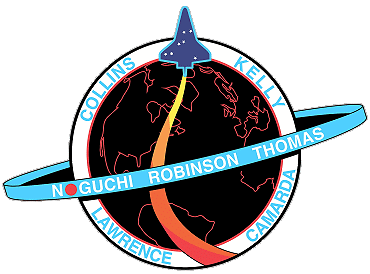 |
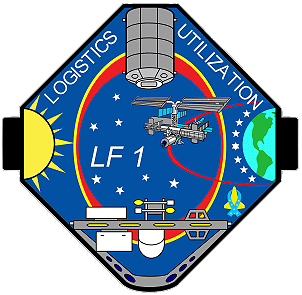 |
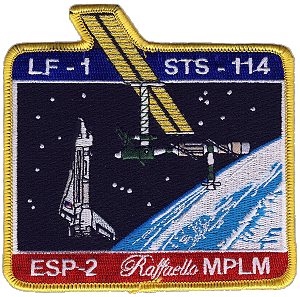 |
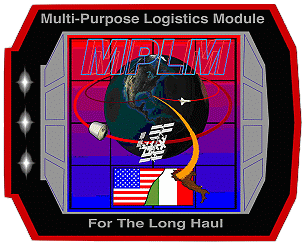 |
|
![]()
Launch, orbit and landing data
walkout photo |
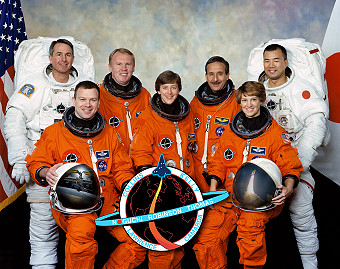 |
|||||||||||||||||||||||||||||||||
alternative crew photo |
alternative crew photo |
|||||||||||||||||||||||||||||||||
alternative crew photo |
alternative crew photo |
|||||||||||||||||||||||||||||||||
alternative crew photo |
||||||||||||||||||||||||||||||||||
Crew
| No. | Surname | Given names | Position | Flight No. | Duration | Orbits | |
| 1 | Collins | Eileen Marie "MOM" | CDR | 4 | 13d 21h 32m 22s | 219 | |
| 2 | Kelly | James McNeal "Vegas" | PLT | 2 | 13d 21h 32m 22s | 219 | |
| 3 | Noguchi | Soichi | MS-1, EV-1 | 1 | 13d 21h 32m 22s | 219 | |
| 4 | Robinson | Stephen Kern | MS-2, FE, EV-2 | 3 | 13d 21h 32m 22s | 219 | |
| 5 | Thomas | Andrew Sydney Withiel | MS-3, IV | 4 | 13d 21h 32m 22s | 219 | |
| 6 | Lawrence | Wendy Barrien | MS-4, RMS, PLC | 4 | 13d 21h 32m 22s | 219 | |
| 7 | Camarda | Charles Joseph | MS-5, PLC | 1 | 13d 21h 32m 22s | 219 |
Crew seating arrangement
|
 |
|
||||||||||||||||||||||||||||||||
Hardware
| Orbiter : | OV-103 (31.) |
| SSME (1 / 2 / 3): | 2057-2 (1.) / 2054-2 (5.) / 2056-2 (3.) |
| SRB: | BI-125 / RSRM 92 |
| ET: | ET-121 (SLWT-22) |
| OMS Pod: | Left Pod 01 (34.) / Right Pod 03 (32.) |
| FWD RCS Pod: | FRC 3 (31.) |
| RMS: | 301 (23.) |
| EMU (launch): | EMU No. 3017 (PLSS No. 1017) / EMU No. 3004 (PLSS No. 1004) / EMU No. 3009 (PLSS No. 1009) / EMU No. 3010 (PLSS No. 1010) |
| EMU (landing): | EMU No. 3017 (PLSS No. 1017) / EMU No. 3004 (PLSS No. 1004) / EMU No. 3005 (PLSS No. 1005) / EMU No. 3011 (PLSS No. 1011) |
Flight
|
Launch from Cape Canaveral (KSC) and
landing on the Edwards
AFB, Runway 22.
It was the first shuttle launch for 907 days. The STS-114 crew was first named in August 2001 with four Space Shuttle astronauts joined by three International Space Station crew members. After the Columbia accident, a decision was made to rotate Station crews on Russian Soyuz spacecraft rather than on the Shuttle. STS-114 (ISS LF1/MPLM 2-03) marked the return to flight of the Space Shuttle after the Columbia disaster and was the second Shuttle flight with a female commander (Eileen Collins, who also commanded the STS-93 mission). The STS-114 mission was initially to be flown aboard the orbiter Atlantis, but NASA replaced it with Discovery after improperly installed gear was found in Atlantis' Rudder Speed Brake system. During OMM for Discovery, an actuator on the RSB system was found to be installed incorrectly. This created a fleet wide suspect condition. The Rudder Speed Brake system was removed and refurbished on all three remaining orbiter vehicles and since Discovery's RSB was corrected first, it became the Return to Flight vehicle over Atlantis. Seventeen years prior, Discovery had flown NASA's previous Return to Flight mission, STS-26. STS-114 was classified as Logistics Flight 1. The flight carried the Raffaello Multi-Purpose Logistics Module, built by the Italian Space Agency. Also, the External Stowage Platform-2, mounting that to the port side of the Quest Airlock. They deployed MISSE-5 to the station's exterior, and replaced one of the ISS's Control Moment Gyroscopes. The CMG and a TPS Repair Box were carried up on the LMC at the rear of the payload bay. The STS-114 mission delivered supplies to the International Space Station. However, the major focus of the mission was testing and evaluating new Space Shuttle flight safety techniques, which included new inspection and repair techniques. The crewmembers used the new Orbiter Boom Sensor System (OBSS) - a set of instruments on a 50-foot (15 m) extension attached to the Canadarm. The OBSS instrument package consists of visual imaging equipment and a Laser Dynamic Range Imager (LDRI) to detect problems with the shuttle's Thermal Protection System (TPS). The crew scanned the leading edges of the wings, the nose cap, and the crew compartment for damage, as well as other potential problem areas engineers wished to inspect based on video taken during lift-off. Around 2.5 seconds after lift-off, a large bird struck near the top of the external fuel tank, and appeared in subsequent video frames to slide down the tank. NASA did not expect this to hurt the mission because it did not hit the orbiter, and because the vehicle was traveling relatively slowly at the time. A small fragment of thermal tile, estimated to be around 1.5 inches (38 mm) in size, was ejected from an edge tile of the front landing gear door at some point before SRB separation. A small white area appeared on the tile as the piece detached, and the loose shard could be seen in a single frame of the video. It is unknown what object (if any) struck the tile to cause the damage. The damaged tile was inspected further when the images from the umbilical camera were downloaded on day three. Engineers requested that this area be inspected by the OBSS, and flight managers scheduled the operation for July 29, 2005. This represented the only known possible damage to Discovery that could have posed a risk during re-entry. At 127.1 seconds after liftoff, and 5.3 seconds after SRB separation, a large piece of debris separated from the Protuberance Air Load (PAL) ramp, which is part of the external tank (see animation, above left). The debris was thought to have measured 36.3 by 11 by 6.7 inches (922 by 279 by 170 mm) – and to weigh about 0.45 kilograms (0.99 lb), or half as much as the piece of foam blamed for the loss of Columbia. The debris piece did not strike any part of the Discovery orbiter. Images of the external tank taken after separation from the orbiter show multiple areas where foam insulation was missing. Around 20 seconds later, a smaller piece of foam separated from the ET and apparently struck the orbiter's right wing. Based on the mass of the foam, and the velocity at which it would have struck the wing, NASA estimated it only exerted one-tenth the energy required to cause potential damage. Laser scanning and imaging of the wing by the OBSS did not reveal any damage. On July 27, 2005, NASA announced that it was postponing all Shuttle flights until the foam loss problem can be resolved. En route to the Station the day after launch, the crew used what was a 100-foot-long (30.5 meters) robotic arm, the 50-foot (15 m) Shuttle arm tipped with a 50-foot-long (15 m) Orbiter Boom and Sensor System (OBSS), to inspect critical heat shield areas. The boom was tipped with two types of lasers and a high-resolution television camera. It was used to inspect key areas of Discovery's wings and nose, the areas that are subjected to the most intense heat during re-entry, for damage. Discovery's approach to the International Space Station during the STS-114 rendezvous and docking process included an unprecedented maneuver - a back-flip pirouette - enabling Station residents to take digital photographs of the Shuttle's thermal protection system. With Discovery's Commander Eileen Collins at the controls, Discovery performed the 360-degree pitch-around with the orbiter about 600 feet (182.9 meters) below the Station. The flip took about nine minutes to complete, offering Expedition 11 Commander Sergei Krikalyov and Flight Engineer John Phillips about 93 seconds of photography time to capture images of Discovery. The images recorded during the Rendezvous Pitch Maneuver (RPM) or R-bar Pitch Maneuver (RPM) are among several new inspection procedures designed to detect and determine the extent of any damage the orbiter's protective tiles and Reinforced Carbon-Carbon surfaces might have sustained. The sequence of events that brought Discovery to its docking with the Station began with the precisely timed launch of the orbiter, placing the Shuttle on the correct trajectory and course for its two-day chase to arrive at the Station. During the first two days of the mission, periodic engine firings gradually brought Discovery to a point about 9 ½ statute miles behind the Station, the starting point for a final approach. About 2 ½ hours before the scheduled docking time on Flight Day 3, Discovery reached that point, about 50,000 feet (15,240 meters) behind the ISS. There, Discovery's jets were fired in a Terminal Initiation (TI) burn to begin the final phase of the rendezvous. Discovery closed the final miles to the Station during the next orbit. As Discovery closed in, the Shuttle's rendezvous radar system began tracking the Station and providing range and closing rate information to the crew. During the final approach, Discovery executed several small mid-course corrections at regular intervals with its steering jets. That placed Discovery at a point about 1,000 feet (304.8 meters) directly below the Station at which time Eileen Collins took over the manual flying of the Shuttle up the R-Bar, or radial vector toward the complex, the imaginary line drawn between the Station and the Earth. She slowed Discovery's approach and flew to a point about 600 feet (182.9 meters) directly below the Station for a period of station-keeping to wait for the proper lighting conditions. The rendezvous was designed so that there was as little glare as possible on the surfaces of the Shuttle. On a verbal cue from Pilot James Kelly to alert the Station crew, Eileen Collins commanded Discovery to begin a nose-forward, three-quarter-of-a-degree-per-second back flip. As the Shuttle passed 145 degrees into the maneuver, James Kelly told Sergei Krikalyov and John Phillips to begin their photography of Discovery. The Station residents took shots from the Shuttle's tail to its nose to avoid any residual glare. The photography was performed out of windows 6 and 7 in the Zvezda Service Module with Kodak DCS 760 digital cameras and 400 mm and 800 mm lenses delivered on a Russian Progress cargo ship to the Station in March 2005. An additional digital camera was delivered as a replacement on a subsequent progress cargo ship in June 2005. The camera replaced one of the two cameras delivered in March 2005 that had failed. The digital camera with the 400 mm lens was used to capture imagery of the upper surfaces of the Shuttle with a two-inch (5.1 centimeters) resolution. The other camera with the 800 mm lens was used to concentrate on Discovery's belly, capturing pictures of the nose landing gear door seals, the main landing gear door seals and the elevon cove with one-inch (2.5 centimeters) analytical resolution. There was enough time for two sets of pictures. After docking was complete, the photos were downlinked through the Station's Ku-band communications system for analysis by systems engineers and mission managers. When Discovery was 215 degrees into the maneuver, James Kelly directed the crew to stop its photography. Discovery then completed its rotation, returning to an orientation with its payload bay facing the Station. Eileen Collins then moved Discovery to a point about 400 feet (121.9 meters) in front of the Station along the direction of travel for both spacecraft, known as the velocity vector, or V-Bar. James Kelly provided Eileen Collins with navigation information as she slowly inched the Shuttle toward the docking port at the forward end of the Station's Destiny Laboratory. Mission Specialists Wendy Lawrence, Stephen Robinson and Charles Camarda also played key roles in the rendezvous. Stephen Robinson operated laptop computers processing the navigational data, while Wendy Lawrence and Charles Camarda shared roles in operating the laser range systems and Discovery's docking mechanism. Using a view from a camera mounted in the center of Discovery's docking mechanism as a key alignment aid, Eileen Collins precisely centered the docking ports of the two spacecraft. She flew to a point where the docking mechanisms were 30 feet (9.14 meters) apart, and paused to check the alignment. For Discovery's docking on July 28, 2005, Eileen Collins maintained the Shuttle's speed relative to the Station at about one-tenth of a foot per second (3 centimeters per second) (while both Discovery and the Station are traveling at about 17,500 mph = 28,163 km/h), and kept the docking mechanisms aligned to within a tolerance of three inches (7.6 centimeters) . When Discovery made contact with the Station, preliminary latches automatically attached the two spacecraft. Immediately after Discovery docked, the Shuttle's steering jets were deactivated to reduce the forces acting at the docking interface. Shock absorber-like springs in the docking mechanism dampened any relative motion between the Shuttle and the Station. Once that motion between the spacecraft had stopped, Charles Camarda secured the docking mechanism, sending commands for Discovery's docking ring to retract and to close a final set of latches between the two vehicles. On the fourth day of the mission, more than 2 ½ years since a Shuttle has delivered supplies to the Station, the crew used the Station's robotic arm to lift an Italian-built cargo module named Raffaello, technically known as a Multi-Purpose Logistics Module (MPLM), out of the Shuttle cargo bay and attached it to the Station. They then began to transfer several tons of supplies and equipment to the Station for use by the Station's Expedition 11 Crew, Commander Sergei Krikalyov and Flight Engineer John Phillips. This was the third trip to the Station for Raffaello, the second of three such cargo carriers to be put into service. Raffaello flew aboard Endeavour on STS-100 and STS-108 in 2001. In addition, Discovery and its crew transferred water to the Station for use in a variety of applications. The first EVA by Stephen Robinson and Soichi Noguchi occurred on July 30, .2005 (6h 50m) for testing thermal protection system repair techniques and installation of the External Stowage Platform-2 Attachment Device (ESPAD) on the space station. After exiting Discovery's airlock, Soichi Noguchi and Stephen Robinson did their initial setup for the spacewalk. This setup period included a trip to the Space Station's Quest airlock on the Station's robotic arm for Soichi Noguchi to open the hatch and provide an emergency entrance point. The crew lock portion of Quest had been depressurized by the Expedition 11 crew the night before. Quest's outer hatch remained open until all three EVAs were completed. Soichi Noguchi closed a thermal cover over the open hatch before returning to Discovery's payload bay to begin the thermal protection repair tests, known as Detailed Test Objective 848 (DTO 848). For DTO 848, the two spacewalkers assisted one another side-by-side in Discovery's cargo bay at a pallet carrying a variety of damaged Shuttle tiles and Reinforced Carbon-Carbon (RCC) samples. Soichi Noguchi and Stephen Robinson had half an hour each to perform their DTO tasks, with 25 additional minutes allocated for cleanup at the tests. Soichi Noguchi worked on tile repair, demonstrating the use of an Emittance Wash Applicator (EWA) and associated tools. The EWA is a dauber-like applicator, used to apply the sticky, caulk-like mixture of fine-grit silicon carbide (SiC) granules and room temperature vulcanizing (RTV) material to exposed tile substrate. Other tools used with this repair technique include foam brushes to cover areas that the larger EWA applicator cannot, and wipes to remove excess material from spacesuits, gloves or tools. His part of the DTO was considered fully successful if one 4-by-4-inch (10-by-10 centimeters) area of exposed substrate is covered. In the "Emittance Wash Applicator dispenses a mixture of fine-grit silicon carbide (SiC) granules and room temperature vulcanizing (RTV) material" application, an emittance wash would be used to repair shallow tile damage. The silicon tiles used in the Shuttle's thermal protection system both reject heat and insulate. The white silicon substrate provides insulation, while the black reaction-cured glass (RCG) coating rejects heat. The ability of a material to reject heat is measured in terms of its "emissivity". The RCG coating on tiles has a high emissivity value, while the white substrate has a lower emissivity value, especially as temperatures rise. The science behind the emittance wash repair involves replacing a damaged tile's coating to restore its ability to reject the high temperatures of atmospheric entry. The emittance wash wicks into the tile substrate, providing an adhesive bond, and a high emissivity, or heat rejection value. For small, shallow areas of damage, replacing the RCG coating with the emittance wash will restore enough heat rejection capability for safe entry. Afterward, Stephen Robinson worked with the RCC crack repair technique. He used a space-hardened caulk gun to dispense a pre-ceramic polymer sealant impregnated with carbon-silicon carbide powder, together known as NOAX (short for Non-Oxide Adhesive eXperimental). Using one of two caulk guns in the crack repair kit, Stephen Robinson dispensed the material onto one of two pallets, similar to those used for plastering. He then used one of two scrapers, similar to putty knives, to work the crack repair material into a pre-damaged RCC sample mounted in the DTO pallet. There were four cracks and two gouges on the RCC sample, and his portion of the DTO was deemed successful if one crack and one gouge are repaired. NASA materials experts have estimated that cracks or coating damage as small as 2 inches (5 centimeters) long and .02 of an inch (5 mm) wide in some locations on the Shuttle's wing leading edge could result in catastrophic damage to that wing. The crack filling method was designed to fix the type of damage most likely to be caused by small pieces of foam coming off the redesigned external tank. NOAX can be used at any RCC location, and does not require any physical modification of the RCC before affecting a repair. It was expected to repair cracks or coating losses up to four inches long, but cannot be used to repair holes. While NOAX initially was thought to need a heater to prepare the RCC surface for application and post-application curing, recent tests on the ground have shown promising results that heating the damaged area and the material may not be required. No heaters were used in the STS-114 tests. After the DTO 848 tasks were complete, the spacewalkers worked to clean up the work area around the DTO pallet before moving on to their assembly get-ahead work. The lid to the sample box was left open until the end of the EVA to allow the OBSS sensors to scan the damaged samples in the box. Removing the External Stowage Platform-2 (ESP-2) Attachment Device (ESPAD) from its Lightweight Multi-Purpose External Support Structure (MPESS) and installing it on the side of the Space Station airlock was the first of those get-ahead tasks. ESPAD is a two-part mechanism, with one part containing the active ESPAD claw, which will provide a temporary structural connection for the ESP-2 when it is first installed. The other half is passive and will remain connected to ESP-2, eventually being grabbed by the claw and then firmly bolted to the active member. They were assisted by James Kelly and Wendy Lawrence inside the Space Station, operating the Station's robotic arm, and by Andrew Thomas inside the Shuttle, who relayed information and instructions from Mission Control. Stephen Robinson's first job was to install an Articulating Portable Foot Restraint (APFR) into the Latching End Effector (LEE) of the Station's 80-foot-long robotic arm. As a free-floater still, he verified that the ESPAD claw is open. He moved a pivoting strut out of the way so that he could remove the first of three bolts which hold the active ESPAD in place for launch. He returned the strut to its original position, and then used a Pistol Grip Tool (PGT), which is a portable drill modified for use in space, to release mounting locks for the Enhanced Universal Truss Attachment System (EUTAS) that was used to attach the active ESPAD member to the airlock structure. The mounting locks were installed pre-flight to prevent vibrations from damaging the EUTAS mechanism. The EUTAS used two knuckled hand-tightening knobs; both could gimble and one could slide to ensure good alignment with the structural members to which they were attached. Once the EUTAS locks were released, he stepped into the foot restraint on the end of the Station's robotic arm and used the PGT to loosen the last two ESPAD launch bolts. After separating the active and passive members, the Station arm was commanded to move Stephen Robinson and the ESPAD from the cargo bay to the Quest airlock trunnions and soft dock the ESPAD with Soichi Noguchi available for guidance. Stephen Robinson hand-tightened the two EUTAS bolts and verified they were tightened well enough to temporarily hold it in place. Then, he used the PGT to finish tightening the bolts and engaged their locking mechanisms. Soichi Noguchi deployed the strut and attached it to a fitting on the Quest airlock. At this point, the ESPAD was ready to structurally accept the ESP-2 on the third spacewalk of the mission. During this same period, Soichi Noguchi's first job was to pre-route the 20-foot-long primary cable that will connect the ESPAD to power connections on the end cone of the Unity connecting module. First, he collected the primary and secondary ESP-2 cables from their launch stowage location in the cargo bay and moved hand-over-hand via handrails to the junction of the Unity module and the Station's truss structure near the Destiny module. At the Crew Equipment Translation Aid (CETA) spur, which bridges the gap between Unity and the truss, he temporarily stowed the secondary cable and moved to the Unity end cone adjacent to Destiny's end cone with the primary cable. He connected one end of the primary cable to a jack on Unity and stowed the rest of the cable on a handrail for later attachment on EVA-3. Next, Soichi Noguchi moved back to the Quest airlock, opened the thermal cover, and retrieved an Orbital Replacement Unit (ORU) bag containing a Global Positioning System (GPS) antenna and another bag containing Control Moment Gyroscope (CMG) get-ahead equipment and stowed them at the Station toolbox on the side of the airlock. With this complete, he moved to the ESPAD installation location to help Stephen Robinson. On July 30, 2005, NASA announced that STS-114 would be extended for one day, so that Discovery's crew could help the ISS crew maintain the station while the shuttle fleet is grounded. The extra day was also used to move more items from the shuttle to the ISS, as uncertainty mounted during the mission as to when a shuttle will next visit the station. The orbiter's arrival also gave the nearly 200-ton space station a free altitude boost of about 4,000 feet (1,220 m). The station loses about 100 feet (30 m) of altitude a day. The second EVA was performed by Stephen Robinson and Soichi Noguchi on August 01, 2005 (7h 14m) to replace a failed International Space Station attitude control gyroscope. The sole objective of EVA-2 was the removal and replacement of a failed Control Moment Gyroscope from the Station's Z1 truss. The old CMG failed in June 2002; since then, the Station had used the remaining three CMGs to maintain and adjust the Station's attitude, or orientation, relative to the Earth. At this stage of the assembly sequence, two CMGs are sufficient to control the Station's attitude. The third functioning CMG provides the necessary amount of redundancy, or backup. However, later in the assembly sequence, the Station will become less symmetrical and a minimum of three CMGs will be needed to maintain attitude. So, four healthy gyroscopes will be needed to control the Station's orientation relative to the Earth and offer a backup if another gyroscope were to fail. Each gyroscope weighs 620 pounds (281 kg) and is about the size of a washing machine. Each has a reaction wheel that spins at a constant speed of 6,600 revolutions per minute. Flight controllers on the ground can use guidance and navigation software to reposition the direction of the gyros' spin axes. Repositioning these axes causes the CMGs to generate torque. This torque is transferred to the Station's structure, counteracting the gravitational and drags forces to maintain attitude or to induce changes to the Station's orientation. After exiting the Shuttle airlock, Soichi Noguchi and Stephen Robinson made sure their spacesuits and tools are in order and worked their way hand-over-hand to the Z1 truss. Soichi Noguchi stepped into an APFR on the Space Station's robotic arm, which again was controlled by James Kelly and Wendy Lawrence. The pair worked together to peel back and secure the multilayer insulation thermal shroud covering CMG-1. After receiving confirmation from Andrew Thomas inside the Shuttle and Mission Control, Soichi Noguchi disconnected four power and data cables and tied them out of the way. Next, they loosened the bolts holding the CMG in its support structure; Soichi Noguchi loosened four bolts and Stephen Robinson two bolts using PGTs. When all six were loosened, Stephen Robinson wiggled the CMG to make sure it is not binding. Each spacewalker then removed two launch shims designed to provide a snug fit for the CMG in it's support structure. Soichi Noguchi removed four captive bolts and Stephen Robinson two, then lifted the CMG out of its cradle. Stephen Robinson used his helmet-mounted video camera to send inspection views of the cavity to Mission Control for evaluation. James Kelly and Wendy Lawrence used Canadarm2 to swing Soichi Noguchi and the failed CMG back to Discovery's payload bay and the Lightweight Mission Peculiar Equipment Support Structure Carrier (LMC). While Soichi Noguchi was in transit, Stephen Robinson moved back to the cargo bay and position two "ball stacks", which were temporary holding arms, to the CMG carrier. When Soichi Noguchi arrived with the old CMG, the pair secured it to one of these ball stacks. Still on the end of the Station's robotic arm, Soichi Noguchi held the new CMG while Stephen Robinson disconnected it from the ball stack holding it to the CMG carrier. Arm operators maneuvered Soichi Noguchi and the new CMG to the Z1 truss, where Soichi Noguchi inserted the new CMG into the empty cavity. Meanwhile, Stephen Robinson moved back to the Z1, managing tethers and reporting clearances to help the robotic arm operators. Once the new CMG was "soft docked" in its cavity (no shims are required), Soichi Noguchi tightened four bolts and Stephen Robinson two. After applying the right amount of torque to the bolts using PGTs, the pair secured the new attitude control device. In careful coordinating with ground controllers, Soichi Noguchi mated four connectors to the jacks in the Z1 truss. He and Stephen Robinson then reinstalled the thermal shroud over the new CMG, reinstalled the floodlight, and moved back to the cargo bay for cleanup and return to the Shuttle airlock. The third and final EVA by Stephen Robinson and Soichi Noguchi was conducted on August 03, 2005 (6h 01m) to attach a massive external tool box to the space station's Quest airlock module, mounting an experiment package on the top of the station's solar array truss, and remove two "gap fillers" sticking up between heat shield tiles on Discovery's belly. On tap are installation of a camera and illuminator package on the port truss structure of the Station, installation of ESP-2, retrieval of two Materials International Space Station Experiment (MISSE) packages and the installation of one new package, MISSE 5 - the first such experiment to have battery power and wireless data transmission capabilities. After exiting the Shuttle airlock with the camera group and ensuring their suits and tools were ready, Soichi Noguchi went to the Video Stanchion Support Assembly (VSSA) in the cargo bay to retrieve the stanchion, while Stephen Robinson removed an orbiter power cable from ESP-2 in preparation for it's removal. Soichi Noguchi removed two launch bolts and floated with the stanchion to the port side of the Shuttle's docking system, positioning it so that Stephen Robinson could remove several bolts holding a connector-protecting dummy box. Next, Stephen Robinson installed the camera group in its stanchion and secured it with three bolts using a PGT. Together, they moved hand-over-hand to the Camera Position 9 worksite at the end of the P1 truss on the Earth-facing side. Soichi Noguchi positioned the stanchion and used a PGT to engage one bolt that anchors the package to the truss. While Stephen Robinson removed one end of the power and data cables from dummy jacks on the VSSA, Soichi Noguchi removed dust caps from the real jacks on the P1 truss and then mated the three cable connectors to the appropriate jacks. Stephen Robinson removed a protective cover from the illuminator and unlocked the camera's pan and tilt mechanism. The last planned task of EVA 3 was the retrieval of two materials exposure experiments and the installation of a new one. Stephen Robinson used handrails to move to the end of the Quest crew lock and took photos of the MISSE 2 experiment package before closing the experiment housing, releasing two PIP pins and removing the suitcase-like package. He placed MISSE 2 in the Quest crew lock for temporary storage, then went to the MISSE 1 location. There, on the Earth-facing side of one of the dog house-shaped oxygen tanks mounted on the exterior of Quest's equipment lock, he performed the same steps on MISSE 2 and closed the airlock thermal cover. Meanwhile, Soichi Noguchi went to the Station airlock and retrieved a spare tether, a clamp and MISSE 5. Moving along handrails, he travelled to the uppermost point on the Space Station, the top of the P6 truss that holds the two large banks of American solar arrays. There, he installed the clamp on a handrail on the P6's aft trunnion and locked MISSE 5 in place. Soichi Noguchi turned the suitcase-like experiment inside-out, exposing its material samples to space. He ensured that the wireless antennas that were used to transfer data were deployed. Those antennas function in the same way that the Station's amateur radio antennas do, and will allow commands to be sent to the experiment package. Telemetry from the experiments will be transmitted every three minutes to the United States Naval Academy near Washington, D.C. or other amateur radio receiving stations around the world. Soichi Noguchi verified that the electronics were turned on before heading back to the Quest hatch. The removal of two "gap fillers" sticking up between heat shield tiles on Discovery's belly was an additional task. If it were not possible to pull the fillers out then the protruding sections could have been simply cut off. The gap fillers are made of a cloth impregnated with ceramic - they are stiff and can be easily cut with a tool similar to a hacksaw blade. Protruding gap fillers are a problem because they disrupt the normally laminar air flow under the orbiter during reentry, which causes turbulence at lower speeds. A turbulent air flow results in a mixing of hot and cold air which can have a major effect on the shuttle temperature. According to NASA, the gap fillers, which each serve different purposes, are not required for reentry. One filler prevents "chattering" of tiles during ascent, which would occur due to the sonic booms from the noses of the solid rocket boosters and the external fuel tank. The other, in a different location where there is a wider gap between tiles, simply functions to reduce the gap size between tiles, which in turn reduces heat transfer to the shuttle. Even without this filler NASA did not expect the increased heat to cause a problem during reentry (it is present to avoid a level of heating which would only be problematic if experienced many times over a vehicle's design life). Since the gap fillers are not necessary for re-entry, it was acceptable to simply pull them out. An overview of the situation, including procedures for dealing with the protrusions were sent electronically to the crew and printed aboard the shuttle. Once Discovery was ready to undock, Charles Camarda sent a command to release the docking mechanism. At initial separation of the spacecraft, springs in the docking mechanism pushed the Shuttle away from the Station. Discovery's steering jets were shut off to avoid any inadvertent firings during the initial separation. Once Discovery was about two feet (61 centimeters) from the Station, with the docking devices clear of one another, James Kelly turned the steering jets back on and fired them to very slowly move away. From the aft flight deck, James Kelly manually controlled Discovery within a tight corridor as the orbiter separated from the Space Station, essentially the reverse of the task performed by Eileen Collins just before Discovery docked. Discovery continued away to a distance of about 450 feet (137.2 meters), where James Kelly initiated a maneuver to fly the Shuttle directly above the Station. At that point, he fired Discovery's jets to depart the vicinity of the Station for the final time. The mission was extended for another day due of bad weather in Florida and was diverted to the Edwards AFB. |
EVA data
| Name | Start | End | Duration | Mission | Airlock | Suit | |
| EVA | Noguchi, Soichi | 30.07.2005, 09:46 UTC | 30.07.2005, 16:36 UTC | 6h 50m | STS-114 | ISS - Discovery | EMU No. 3017 |
| EVA | Robinson, Stephen | 30.07.2005, 09:46 UTC | 30.07.2005, 16:36 UTC | 6h 50m | STS-114 | ISS - Discovery | EMU No. 3004 |
| EVA | Noguchi, Soichi | 01.08.2005, 08:42 UTC | 01.08.2005, 15:56 UTC | 7h 14m | STS-114 | ISS - Discovery | EMU No. 3017 |
| EVA | Robinson, Stephen | 01.08.2005, 08:42 UTC | 01.08.2005, 15:56 UTC | 7h 14m | STS-114 | ISS - Discovery | EMU No. 3004 |
| EVA | Noguchi, Soichi | 03.08.2005, 08:48 UTC | 03.08.2005, 14:49 UTC | 6h 01m | STS-114 | ISS - Discovery | EMU No. 3017 |
| EVA | Robinson, Stephen | 03.08.2005, 08:48 UTC | 03.08.2005, 14:49 UTC | 6h 01m | STS-114 | ISS - Discovery | EMU No. 3004 |
Photos / Graphics
 |
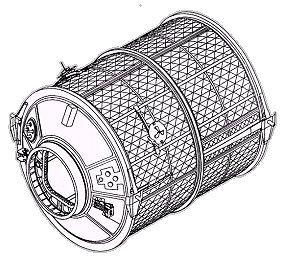 |
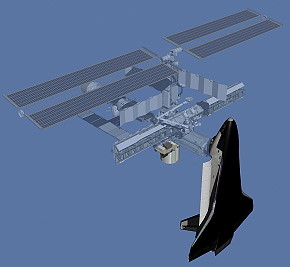 |
 |
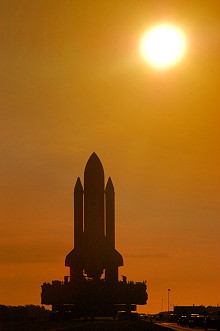 |
 |
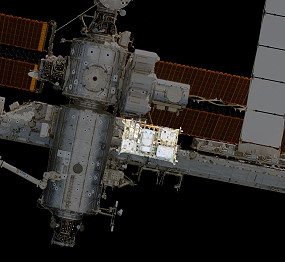 |
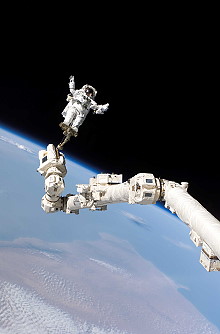 |
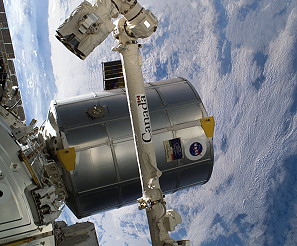 |
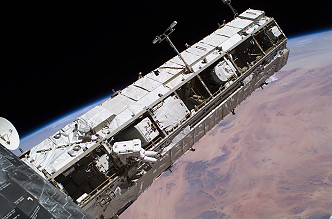 |
 |
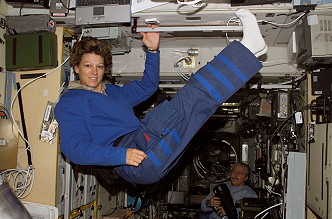 |
 |
 |
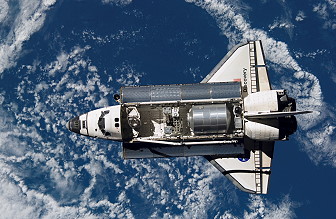 |
 |
 |
 |
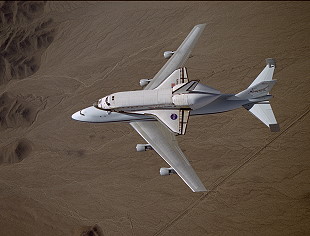 |
|
more EVA photos |
|
| © |  |
Last update on March 27, 2020.  |
 |